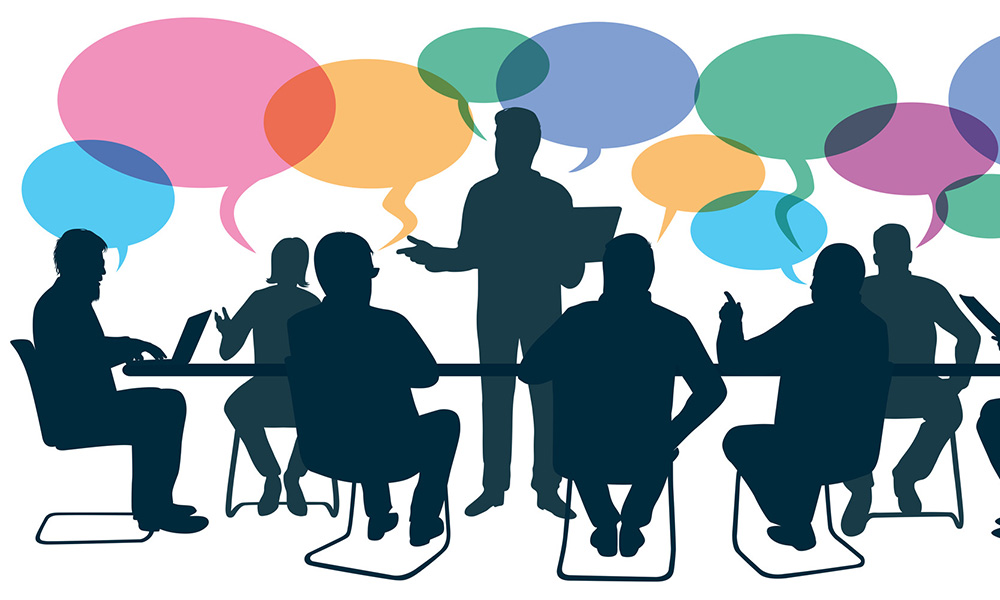The average Facebook user in America spends about 40 minutes a day on it. Estimates suggest that the global average is over 20 minutes or so. That’s a lot of time spent scrolling through updates on people, many of whom you probably haven’t even met in years. And that isn’t counting the time on Twitter or Instagram or any other social networking platform. So, we are apparently much more connected that we have ever been. Look around you at the number of people poring over their phones – at their desks, walking down the corridor, and unfortunately, even during meetings. You’ll probably even catch more people on their phones during lunch, than in conversation or even eating! And more often that not, you’re probably one of those people too.
Now ask yourself this – for as connected as you are becoming, how many people can you name who work on the same floor as you? How many of them have you had a conversation with – beyond a nod in the corridor? How many do you know beyond their roles and designations? How well do you know your own team members? Do you know the names of their partner and children? How often do you invite you close colleagues home? When was the last time you introduced yourself to someone new at work?
Certainly, you can argue that the focus for you at work, is to get work done, not make friends. But here’s a fact – where we work is very much a social place. At the heart of it, our business is all about people and collaboration. It is these relationships that translate into all our successes. And given that we spend the most part of our waking day at work, these relationships really matter.
Unfortunately, though, increasingly, we are becoming more transactional and impersonal at work. The supposed need for efficiency is trumping building meaningful relationships.
So, drawing from this, my message this week focuses on why you need to build friendships at work – why this is so important for collaboration, how you can leverage relationships better, and what you can do to start becoming more effective at fostering this.
Why have friends at work?
Because it makes work more fun and makes you happier. And that really is reason enough. At Godrej, we are selfish about your happiness. Why? Because we believe that happier team members are more engaged, collaborate better, work more effectively and contribute much more meaningfully.
Employee engagement isn’t just a feel good, nice to have metric. It is a very real determinant of how successful we will be as a company. As Christine M. Riordan points out in her Harvard Business Review article ‘We All Need Friends at Work’, “Camaraderie is more than just having fun… It is also about creating a common sense of purpose and the mentality that we are in it together… In short, camaraderie promotes a group loyalty that results in a shared commitment to and discipline toward the work.”
There is a lot of research that shows that people with more friends at work are more engaged with their companies.
Think about it. When you’re able to hang out together, laugh and joke a bit, know where the other person is coming from – it just makes it so much easier when you need to trade ideas, ask for support, move deadlines around and pull all those late nights.
Gallup, the global consultancy, has a famous list of statements used to measure employee engagement. One of these and arguably the most controversial, is “I have a best friend at work”. And the results are very clear.
There is a high correlation between people forging close friendships and working productively in teams. It boosts employee satisfaction by a significant 50%.
People with a best friend at work are also seven times more likely to engage fully in their work, than others. Like Gallup points out, we often focus so much attention on the relationship between the company and team members, that we forget that there is an equally important relationship between team members.
When people can be friends first, trust follows much more easily. Given the kind of macro economic volatility that our businesses are functioning in, dealing with change is a pre requisite. With that comes the need to adapt, manage uncertainty and be more flexible. And all of it is much easier when you are collaborating with people who you trust to have your back. Friends are more likely to be open with feedback, share information, give credit where due and take ownership when things don’t go according to plan.
When you get a chance, do read Adam Grant’s New York Times article on this – ‘Friends at Work? Not So Much’ (http://www.nytimes.com/2015/09/06/opinion/sunday/adam-grant-friends-at-work-not-so-much.html?_r=0).
Building stronger relationships at work
As senior leaders, we play a very critical role in fostering this friendship culture at Godrej. And we will need to walk the talk on this. For many of us, this needs to be much more than just having good friends at work who we can partner with. We need to find ways to extend our camaraderie to our larger teams and look for ways to encourage other people to make friends across teams.
Here are some suggestions on how you can go about it:
1. Don’t fake it
This will take effort. You need to be authentic. So, before you start, introspect. Do this because you believe this is important. You have to genuinely care for people. Figure out what you are comfortable with doing and the approach you want to take. Perhaps find people with shared interests. There is no standard answer to this. You will find your own.
2. Find the time
I have heard people say that they don’t have time for this kind of small talk at work. But this is much more than just that. You need time to foster these relationships. When it comes to your team members, you should probably even calendar it in. The same goes for any other people who you need to build deeper relationships with. And start looking for everyday occasions that you could leverage better. This could be anything – breaks between meetings, the time before a meeting starts, when you’re walking the corridors, on the staircase or in the elevator.
It really doesn’t take that much effort to get started. For instance, here is a suggestion – think about your lunch time. Do you typically have lunch alone or just with the same set of people everyday? Why not make it a point to have lunch with a different set of people a few times a week? It can be as simple as that. Personally, I have realised that it helps being disciplined about it. Every quarter, I put on my calendar the various people that I want to meet for lunch or coffee to stay connected and to maintain the relationships. I have found that it works very well.
3. Get creative
Companies today are looking for new ways to make this whole process of reaching out to and connecting with people you would not have otherwise met, much more engaging. Take Lunch Roulette (http://lunchroulette.us/index.html) for example – an automated process that randomly pairs people within an organisation for lunch. (Not surprisingly, it was created by David Thompson, after a lonely lunch at the office cafeteria when his usual lunch buddies weren’t around!) If the people you interact with often are not based in the same city or even country as you are, try using technology more effectively. So, Skype instead of just calling someone. It always helps to put a name to a face.
4. Start with your own team
You can’t make people be friends, but you can certainly help create more occasions for them to get to know each other better. Set up team lunches, dinners and other interesting events. This is really easy to do – and many of us probably do it anyway. But make them regular, get people involved in planning them. Find something new to do each time. Maybe even invite a couple of people who you would like your team to get to know better to them.
During my last visit to Argentina, rather than go to a restaurant for dinner, Anand suggested that I come over to his place. He made a delicious meal (with me helping him a bit) and we spent more than 3-4 hours catching up in a more informal setting. (One other small point on this – in a team event, try to stay for the whole event. Don’t just show your face and disappear. Don’t pay lip service. Use the time to build relationships.)
5. The multiplier effect
Selecting the right people to build relationships with, is half the work done. Make connections beyond your team. These are the people who will have a multiplier effect. A strong relationship with them will translate into strong relationships with their team members and other colleagues.
I know that many of you will have great suggestions on what we can do differently to enable some of this. Do share your stories and what has worked for you, with the rest of our team.
As always, I look forward to hearing from you.








Vivekji, this is an excellent thought, always worked for me. I’ve been associated with Berger Paints India. My days there were fruitful (personally and professionally) only because of my friends there. They gave me an immense amount of support, most practical opinions, and great motivation. My interactions with them were more beneficial for me than the corporate training from the company.
Completely agree, Vivek. Coming from a defence background, I can so relate to this. Thanks for the reminder.
Hi Vivek, I read your blog every week (almost) and I must say, this is by far the most important blog I related to 🙂
Given the day and age, with technology playing such an important factor in our life, we sometimes forget to connect with those who are present around us in flesh and blood. And as you rightly said, nothing beats a face-to-face conversation.
The friends you make at work, not only help you in the long term, but are also THE critical binding factor for one to stick at a workplace.
Look forward to more of these 🙂